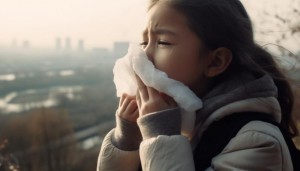 Statistics and research indicate that the number of sand and dust processes in East Asia during the same period is approximately 5-6, and this year’s sand and dust weather has exceeded the average of previous years. The acute exposure of the human respiratory system to high concentration of sand and dust particles can shorten the average life expectancy, increase the incidence rate of cardiovascular and respiratory diseases, and show a significant lag phenomenon. In addition to the influence of large particles, fine particles (PM2.5) and ultrafine particles (PM0.1) in sand and dust can penetrate into the human body due to their small particle size, posing greater harm to human health.
Statistics and research indicate that the number of sand and dust processes in East Asia during the same period is approximately 5-6, and this year’s sand and dust weather has exceeded the average of previous years. The acute exposure of the human respiratory system to high concentration of sand and dust particles can shorten the average life expectancy, increase the incidence rate of cardiovascular and respiratory diseases, and show a significant lag phenomenon. In addition to the influence of large particles, fine particles (PM2.5) and ultrafine particles (PM0.1) in sand and dust can penetrate into the human body due to their small particle size, posing greater harm to human health.
Areas with severe sand and dust levels have even issued regulations to suspend outdoor work, and its hidden dangers are self-evident, as adverse weather can also cause certain harm to human health.
How to take preventive measures?
·Try to avoid outdoor activities, especially for the elderly, children, and those with respiratory allergic diseases, and promptly close doors and windows indoors.
·If you need to go out, you should bring dust prevention equipment such as masks and goggles to avoid damage to the respiratory tract and eyes caused by sand and dust.
·A sandstorm can have a strong smell of dirt at home, which can be cleaned with a vacuum cleaner or a damp cloth to avoid the resuspension of indoor dust.
·Indoor air purifiers or air filters can be equipped if conditions permit, which can purify indoor air and effectively kill viruses and bacteria in the air.
·SAF multistage air filtration system has air filters of different filtration levels to reduce the concentration of dust and microbial aerosols in the air.
We use bag filters and box filters as two-stage pre filtration sections to remove coarse and medium efficiency particles.
The EPA, HEPA, and ULPA filters of SAF serve as the final stage filters, responsible for effectively capturing small particles and bacteria.
Post time: May-24-2023

